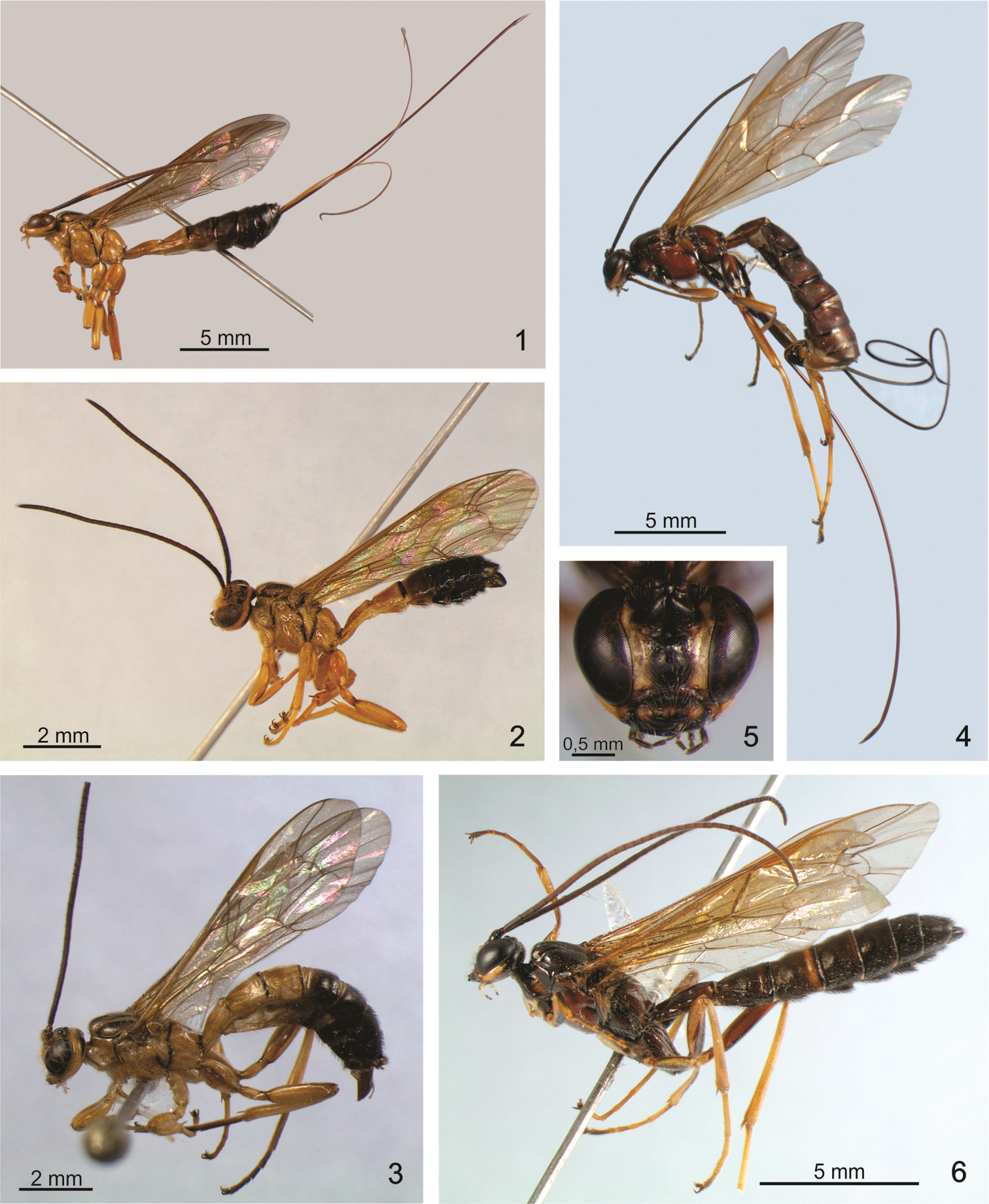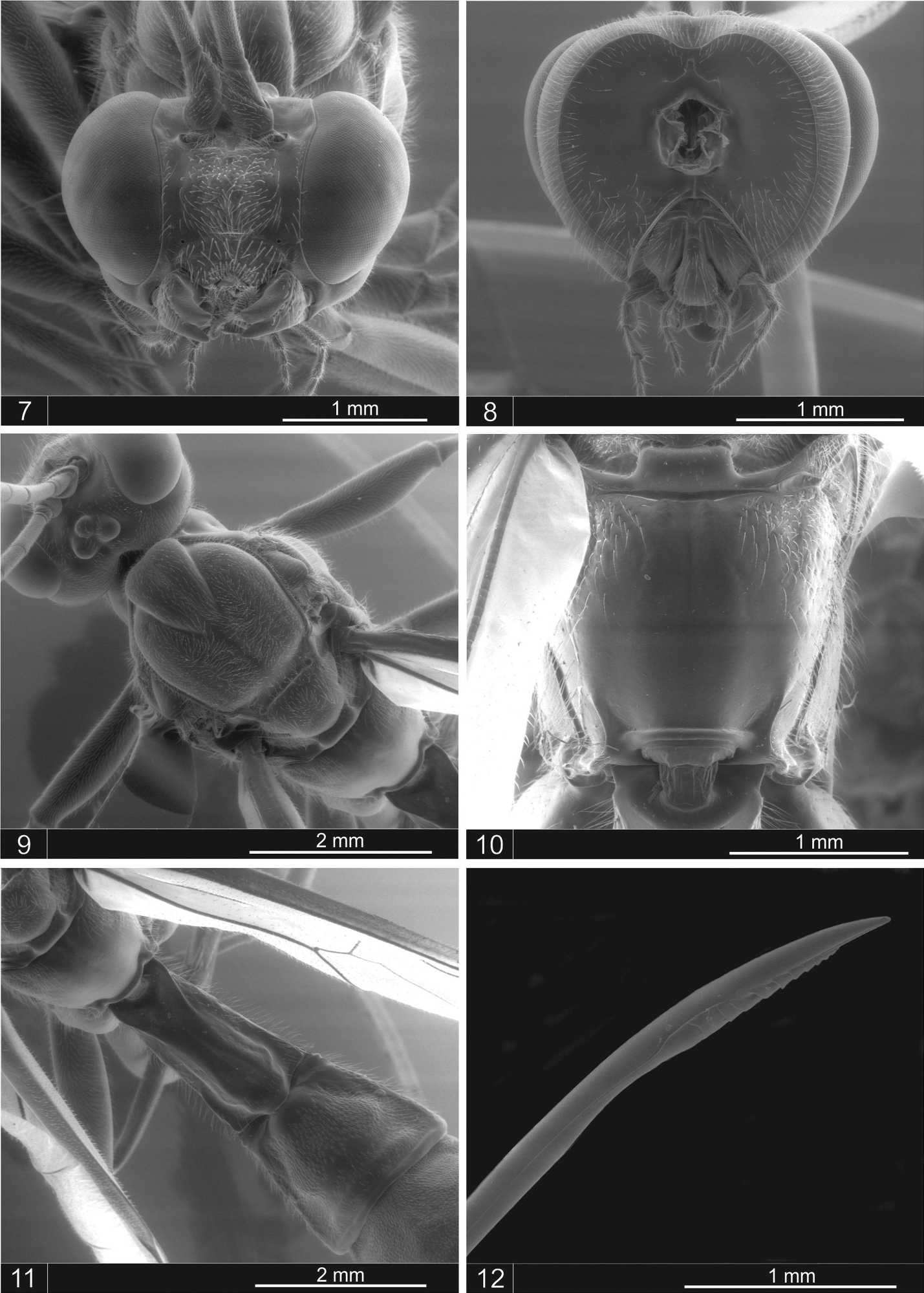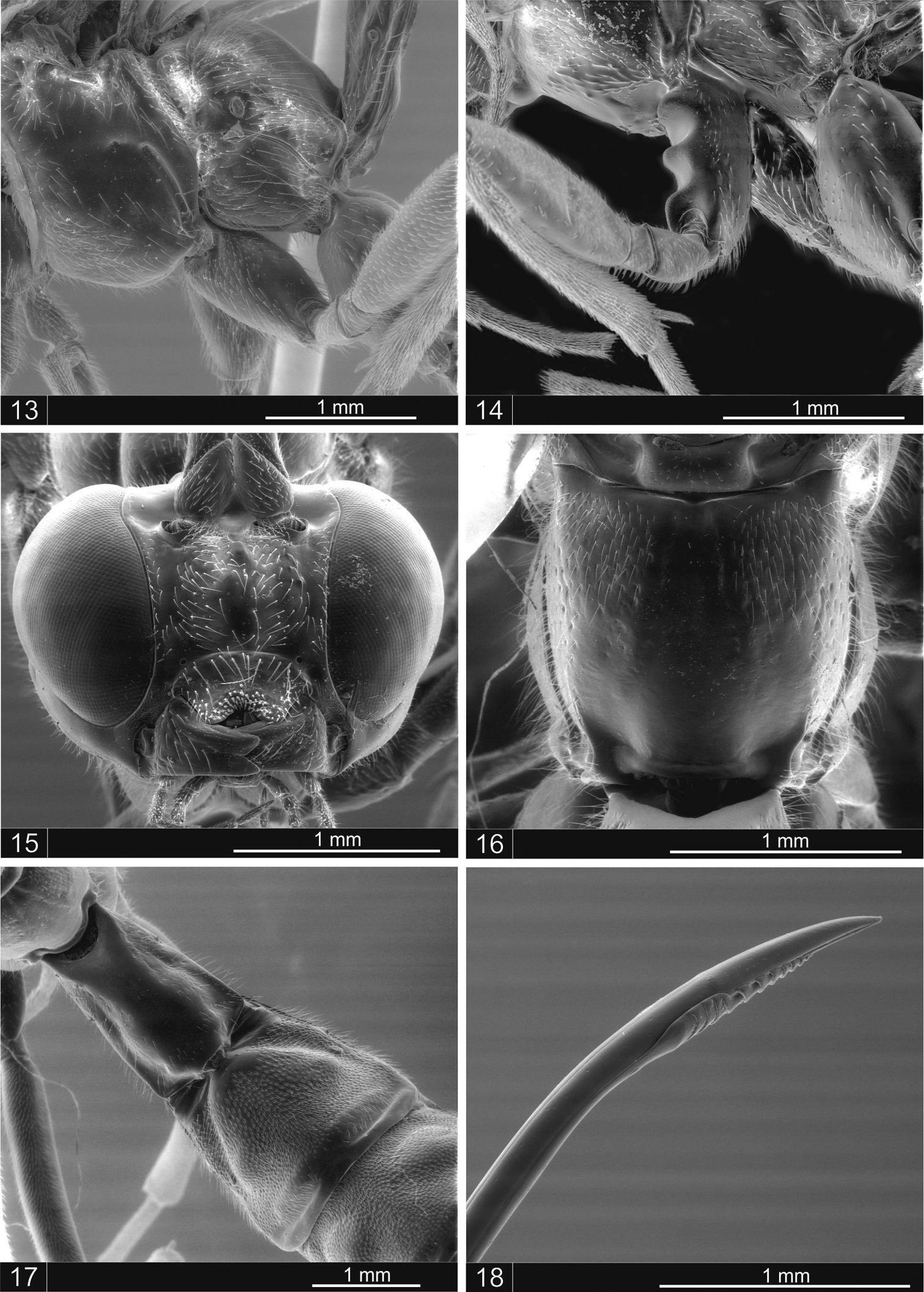






(C) 2012 Ana Paula da Silva Loffredo. This is an open access article distributed under the terms of the Creative Commons Attribution License 3.0 (CC-BY), which permits unrestricted use, distribution, and reproduction in any medium, provided the original author and source are credited.
For reference, use of the paginated PDF or printed version of this article is recommended.
In the present study, two new species of Pimplinae, Dolichomitus jatai sp. n. and Dolichomitus moacyri sp. n. are described, and the distribution range of Dolichomitus annulicornis (Cameron, 1886) is extended. The specimens were collected using Malaise traps in areas of Atlantic forest and Brazilian savannah (cerrado) in southeastern Brazil and are deposited in a Brazilian collection (DCBU).
Neotropical, new species, savannah, distribution
Dolichomitus Smith, 1877 includes 72 species, with 13 recorded from the Neotropics (
The examined specimens were collected using Malaise traps in different localities of southeastern Brazil and are deposited in the DCBU collection (Departamento de Ecologia e Biologia Evolutiva, Universidade Federal de São Carlos, São Carlos, SP, Brazil). The terminology used mostly follows
urn:lsid:zoobank.org:act:D9531345-3F6C-4394-A950-D48544A334D8
http://species-id.net/wiki/Dolichomitus_jatai
Figures 1–2, 7–13Type locality. Brazil, SP, Luís Antônio, Estação Ecológica de Jataí, 21°35'16.7"S, 47°47'43.9"W; 15.X.2009; Brazilian savannah, N.W. Perioto and team col., Malaise trap.
Holotype pinned (DCBU): female, Brazil, SP, Luís Antônio, Estação Ecológica de Jataí, Brazilian savannah, 21°35'16.7"S, 47°47'43.9"W, 15.X.2009, Armadilha Malaise II, N.W. Perioto and team col.
Paratypes (DCBU). 1 female, same as the holotype, 16.IX.2009; 2 females and 1 male, same as the holotype, 21°36'10.2"S, 47°46'47.6"W, 16.IX.2009, 27.V.2009 and 03.IX.2008, respectively; 1 male, Brazil, SP, Macaubal, 20°44'34"S, 49°55'45"W, 03.IV.2008, semideciduous seasonal forest, F. Noll col., Malaise trap; 1 male, Brazil, SP, Itirapina, 22°13'09"S, 47°54'04"W, 6.XII.2008, riparian forest, A.M.P. Dias col., Malaise trap; 1 male, Brazil, SP, São Carlos, Fazenda Pinhal, 22°08' 21.80"S, 47°50' 56.57"W, 20.XI.2004, A.M.P. Dias col., Malaise trap.
Holotype: female (Fig. 1). Body length: 13.7 mm; fore wing length: 9.0 mm. Head (Fig. 7). Antenna with 35 segments, the last flagellomere 2.5x as long as the anterior; mandible with upper tooth more or less equal in length to the lower tooth; clypeus apically bilobate; lower face centrally punctuated with hairs. Occipital carina mid-dorsally dipped; occiput with a mid-dorsal notch (Fig. 8). Anterior margin of pronotum reflexed upward; epomia distinct; mesoscutum with setiferous punctures; notauli very strongly impressed anteriorly (Fig. 9). Mesopleuron smooth and shiny centrally; epicnemial carina very strong ventrally, with a shallow mid-ventral dip; metapleuron punctate with hairs; submetapleural carina complete; propodeum (Fig. 10) dorsally smooth, with setiferous punctures anterolaterally; pleural carina complete.
Metasoma: Tergite I of the metasoma (Fig. 11) with a smooth central area that is defined laterally by carinae convergent posteriorly to the hind margin; tergite II punctuate with hairs, 1.1 times as long as posteriorly broad, with a shallow groove anterolaterally, margin posteriorly smooth and polished; tergites III + with setiferous punctures, posterior margin smooth and polished. Ovipositor 5.6 times the length of the hind tibia, more or less straight (Fig. 12).
Color: Yellow and black or dark brown; head yellow, tips of mandible and occiput black; antenna with scape and pedicel yellow, proximal five flagellomeres black, the 6th and 7th yellow, the remainder brownish; mesoscutum with three black stripes; the anterior margin and posterior lateral margin of the propodeum with a narrow black stripe; pronotum, mesopleuron and metapleuron with a black posterior margin; the posterior margin of tergites II–VI black; tergites III+ dark brown. Legs yellow, fore-femur black, striped dorsally; tips of all tarsal claws brownish yellow. Ovipositor sheath brownish. Wings yellowish; pterostigma brownish.
Male (Fig. 2). Essentially as the female but with body length 10.9 mm; fore wing all yellowish with length 8.6 mm; antenna with 34 segments, the last flagellomere 1.5x as long as the anterior; the proximal four segments brown, the 5th, 6th and 7th slightly yellowish and the remainder brownish; mid-coxa with surface evenly convex (Fig. 13).
The name of the species refers to the locality of collection of the material for study.
Brazil.
Dolichomitus jatai sp. n. seems to belong to the zonatus species group, which are vespid mimics and are predominantly yellowish with brown or black marks; the wings are yellowish, and the males have shorter bodies. This species is similar to Dolichomitus annulicornis (Fig. 3), differing in the color of the flagellomeres: whereas the proximal five flagellomeres are black and the 6th and 7th yellow in Dolichomitus jatai sp. n., the proximal three or four flagellomeres are black and the next four or five whitish yellow in Dolichomitus annulicornis. The propodeum is dorsally smooth in Dolichomitus jatai sp. n., whereas in Dolichomitus annulicornis, there is a smooth and polished area that widens posteriorly. The males of the two species differ in the form of the mid-coxa: in Dolichomitus annulicornis, there are prominences separated by deep concavities (Fig. 14), and in Dolichomitus jatai sp. n., the surface of the mid-coxa is evenly convex (Fig. 13). In Dolichomitus zonatus, the propodeum is similar to that of Dolichomitus annulicornis, but it is narrower posteriorly. Dolichomitus cantillanoi has a narrower median longitudinal groove and distinct lateromedial secondary furrows, which are never present in Dolichomitus zonatus, Dolichomitus annulicornis or Dolichomitus jatai sp. n. Dolichomitus bivittatus, Townes, 1975, and Dolichomitus hypermeces, Townes, 1975, are different in color and have longer ovipositors, 12.0× and 21.0× as long as the hind tibia, respectively.
urn:lsid:zoobank.org:act:B0EC55E4-559B-42CD-982C-011048779C4C
http://species-id.net/wiki/Dolichomitus_moacyri
Figures 4–6, 15–18Type locality: Brazil, SP, Poços de Caldas, Sítio da Ferradura, S 21°47'3.4"S, 46°37'22.8"W, 13.X.2006, riparian forest, A.E. de Carvalho col., Malaise trap.
Holotype pinned (DCBU): female, Poços de Caldas, SP, Brazil, Sítio da Ferradura, 21°47'3.4"S, 46°37'22.8"W, riparian forest, 13.X.2006, Malaise trap.
Paratypes (DCBU): 1 female, Brazil, SP, Itapeva, Estação Ecológica de Itapeva, 24°4'10.7"S, 49°4'10"W, 15.IV.2008, Brazilian savannah, A.M.P. Dias col., Malaise trap; 1 male, Brazil, SP, Santa Rita do Passa Quatro, Parque Estadual de Vassununga – Pé-do-gigante, 21°40'56"S, W 47o37'13"W, 08.X.2007, riparian forest, A.M.P. Dias col., Malaise trap.
Holotype: female (Fig. 4). Length: 16 mm; fore wing length: 12 mm. Antenna with 37 segments; the last flagellomere 2.5× as long as the anterior; mandible with upper tooth more or less equal in length to the lower tooth; clypeus apically bilobate; lower face (Fig. 15) centrally punctuated; occipital carina mid-dorsally dipped. Epomia distinct; mesoscutum with setiferous punctures; notauli very strongly impressed anteriorly. Mesopleuron mostly centrally smooth and polished, with setiferous punctures; epicnemial carina weak laterally; metapleuron with setiferous punctures; submetapleural carina complete. Propodeum with vestigial lateromedial longitudinal carinae posteriorly divergent with central area smooth, anterolaterally with setiferous punctures (Fig. 16); pleural carinae complete.
Metasoma: Tergite I (Fig. 17) with a smooth central area defined laterally by carinae convergent posteriorly to the hind margin; tergites II punctuate with hairs, 0.8 times as long as posteriorly broad, with a shallow groove anterolaterally; tergites III–V with setiferous punctures and a pair of lateromedial swellings and posterior margin narrow, smooth and polished; tergites VI+ punctate with hairs. Ovipositor 5.0 times the length of the hind tibia, with apex declined (Fig. 18).
Color: Reddish-brown with black and yellow markings. Head yellow with vertex brown; occipital region, central frons and mandible black (Fig. 5); antenna dark brown, three black stripes on mesoscutum; dorselum yellow; propleuron black; tergite I of metasoma brownish, tergite II+ reddish brown; distal tarsomeres dark brown; coxa of first pair of legs black with a whitish spot anteroventrally; trochanter brown, whitish ventrally; trochantelus dark brown; femur and tibia yellow with a black stripe laterally; tarsomeres I–IV yellow, dorsally brown; coxa and trochanter of the second pair of legs dark brown, whitish ventrally; trochantelus brown, femur and tibia yellow with a black stripe laterally; tarsomeres I–IV yellow, dorsally brown; hind leg with coxa orange-brown; trochanter, trochantelus and femur yellow, ventrally brown; tibia and tarsomeres I–II yellow; tarsomeres III–IV and ovipositor sheath dark brown; wings yellowish, fore wing with anterior margin more fuscous; pterostigma yellow.
Male (Fig. 6). Length: 13.3 mm. Fore wing: 11.0 mm; mid-coxa evenly convex. Similar to female, antenna with 40 segments; the last flagellomere 1.5× as long as the anterior.
One female with the first pair of coxa and trochanter yellowish ventrally.
The name of the species is in honor of Moacyr de Carvalho Dias, the owner of the Sitio da Ferradura.
Brazil.
Dolichomitus moacyri sp. n. does not seem to belong to any of
Dolichomitus jatai sp. n. female. 1 lateral habitus 2 male, lateral habitus. Dolichomitus annulicornis 3 lateral habitus. Dolichomitus moacyri sp. n., female 4 lateral habitus 5 head, frontal view 6 male, lateral habitus.
Dolichomitus jatai sp. n., female. 7 head, frontal view 8 head, posterior view 9 mesoscutum, dorsal view 10 propodeum, dorsal view 11 tergites I–II 12 ovipositor tip.
Dolichomitus jatai sp. n., male. 13 mid-coxa, lateral view. Dolichomitus annulicornis, male14 mid-coxa, lateral view. Dolichomitus moacyri sp. n., female 15 head, frontal view 16 propodeum, dorsal view 17 tergites I–II 18 ovipositor tip.
We are grateful to the Conselho Nacional de Desenvolvimento Científico e Tecnológico (CNPq), Fundação de Amparo à Pesquisa do Estado de São Paulo (FAPESP), and Instituto Nacional de Ciência e Tecnologia dos Hymenoptera Parasitoides da Região Sudeste Brasileira (INCT- HYMPAR/SUDESTE) for financial support; to the Instituto Florestal do Estado de São Paulo and the managers of Parque Estadual de Vassununga, Estação Ecológica de Jataí, Estação Ecológica de Itapeva and Fazenda Pinhal for granting permission to collect insects; to Moacyr de Carvalho Dias for allowing us access to the Sitio da Ferradura, Poços de Caldas; and to Luciana Bueno dos Reis Fernandes for her assistance with the pictures.


